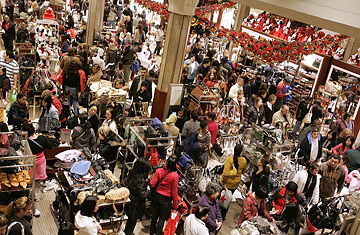
Shoppers at Macy's on Black Friday, the day after Thanksgiving, 2006.
Black Friday, the day after Thanksgiving when retailers traditionally start going from "being in the red" to "being in the black," might look a different shade this year. And that's not a good thing for retailers.
The supposedly biggest shopping day of the year falls on the earliest possible date, November 23, giving Americans 32 days before Christmas to find the perfect gift. But with the specter of a possible looming recession and a lack of must-have items in stores, fewer Americans are likely to leave the couch and hit the mall with the same kind of alacrity and determination they have in years past. "Black Friday is going to be a gray Friday," says Marshal Cohen, chief retail analyst at the NPD Group, a market research firm in Port Washington, New York.
Most forecasts share Cohen's pessimistic outlook, predicting that sales growth this holiday season will be anywhere from 3.3% to 4.5%, down as much as 1.6 percentage points from last year's comparable 4.9% sales growth. But Cohen thinks the consumer apathy already seen this holiday season is due more to a lack of must-have items than fears of a slowing economy. "The number one reason this is a hesitation holiday is the absence of newness and excitement," says Cohen. "There is nothing we really have to have."
The iPhone has been out for a while. Flat-screen TVs, Nintendo's Wii and PlayStation 3 were big last year, which means not as many will show up on Christmas lists this year — though lower priced games for the consoles will. We have no shearling boot craze or jean shortages. Instead, lower ticket items like the popular video game Guitar Hero III and Barbie Girls MP3 Players are big, and accessories such as handbags will do well. Dave Sievers from Archstone Consulting predicts a $7 billion increase in gift cards this season, reaching $35 billion, compared to the $28 billion spent on them last year. Likewise, online shopping continues to rise, with forecasts predicting between 18 and 21% growth. Both those trends mean customers are not hanging around stores and the mall as long, and Cohen says that should translate into fewer impulse buys, which have traditionally made up 26% of holiday purchases.
Retailers love to blame the weather for their woes, but it's true that this fall's record-breaking warm temperatures have led to sluggish fall and winter clothing sales. They have been so slow, in fact, that many retailers have already started their holiday price-cutting to get rid of the excess sweaters and coats. Due to tepid results the last two Christmas seasons, Wal-mart is determined to get a jump on sales. They reduced prices on toys in September and then slashed them again on 15,000 additional items in October, a 20% increase over last year. By November they were offering the kinds of deals usually reserved for Black Friday. Likewise, Toys R US, KB Toys and Circuit City started their promotions the first weekend in November. "Shoppers know the sales have already taken place and will occur again," says Candace Corlett, President of WSL Strategic Retail, an organization that studies how Americans shop.
Even those who do decide to brave the stores the day after Thanksgiving for the traditional early-bird specials may not be in a spending mood. Americans are facing higher food, gas and energy prices this year, expenses that make up close to 20% of the typical consumer budget, according to Bain & Company's retail holiday report. And many people are feeling the pinch from the continuing credit crunch, including higher mortgage costs and the depreciation in home values. "Consumers have the highest debt they have ever had with 24 months of negative savings," says Howard Davidowitz, chairman of Davidowitz & Associates Inc., a national retail-consulting firm. "They can't use their homes as piggy banks anymore."
Indeed, over the past decade home equity loans have helped finance a lot of big-ticket holiday purchases. And with that resource increasingly hard to tap, middle and lower-income shoppers probably will not spend as much on discretionary purchases. Forty-four percent of consumers polled in WSL Strategic Retail's How America Shops survey said they expect to spend less this holiday season. "This year customers won't trade up," says Cohen. "If I am a Target shopper I will stay there. Last year I was a Wal-mart shopper going to Bloomingdales because I felt good."
But not everyone will lose out this Christmas. The very low and very high end of the retail market should be just fine. While middle-of-the-road stores like Kohl's, J.C. Penney and the Gap that have struggled in the recent past will probably continue to suffer, high-end stores like Neiman Marcus, Saks Fifth Avenue and Nordstrom's will most likely have relatively strong sales. "They have a moneyed customer and things happening in the world won't affect their lifestyle as much," says Michael Appel, managing director of Quest Turnaround Advisors. "Well-managed retailers who already have momentum will continue to see that." At the same time discount chains like Costco and Sam's Club will also benefit.
"The onus is on the retailer to get creative," says Corlett, of WSL Strategic Retail. That means text messages alerting people to sales, inviting customers in for exclusive shopping events or serving a complimentary breakfast to lure Black Friday shoppers, as Sam's Club will do to try to get the big day off to the right start..
